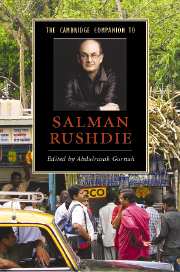Book contents
- Frontmatter
- 1 Introduction
- Part I: Themes and Issues
- Part II: Studies of Individual Texts
- 6 Tricksters and the common herd in Salman Rushdie’s Grimus
- 7 Themes and structures in Midnight’s Children
- 8 Reading ‘Pakistan’ in Salman Rushdie’s Shame
- 9 The Satanic Verses: ‘To be born again, first you have to die’
- 10 The shorter fiction
- 11 The politics of the palimpsest in The Moor’s Last Sigh
- 12 The Ground Beneath Her Feet and Fury: The reinvention of location
- Guide to further reading
- Index
- Series List
11 - The politics of the palimpsest in The Moor’s Last Sigh
from Part II: - Studies of Individual Texts
Published online by Cambridge University Press: 28 November 2007
- Frontmatter
- 1 Introduction
- Part I: Themes and Issues
- Part II: Studies of Individual Texts
- 6 Tricksters and the common herd in Salman Rushdie’s Grimus
- 7 Themes and structures in Midnight’s Children
- 8 Reading ‘Pakistan’ in Salman Rushdie’s Shame
- 9 The Satanic Verses: ‘To be born again, first you have to die’
- 10 The shorter fiction
- 11 The politics of the palimpsest in The Moor’s Last Sigh
- 12 The Ground Beneath Her Feet and Fury: The reinvention of location
- Guide to further reading
- Index
- Series List
Summary
The Moor's Last Sigh, Rushdie's first major publication after The Satanic Verses, was written in the shadow of the fatwa and in the wake of Rushdie's political exile from his former homeland. The novel appears to replicate the author's predicament by foregrounding a sense of banishment and impending death, opening and closing the eponymous Moor's narrative with his premature death in exile. Exile and death thus frame the rich narrative collage that constitutes this saga of the Catholic-Jewish Da-Gama-Zogoiby family, containing the events in a foreclosed temporal register that offers both cultural and historical density to the text. The Moor's retrospective narration 're-covers' - simultaneously reclaims and layers - four generations of family history drawing intricate connections between fiction and history by drawing on the trope of the palimpsest - a writing surface upon which the original traces have been overwritten. This trope - which I explore in depth later - is central to the model of historiography as re-covery in the text and reflects the contingency of historical narration, its production within a specific historical moment. Indeed, this novel is one of Rushdie's most 'readerly' texts in that its prime concern, as Stephen Baker has pointed out, is 'the rediscovery of a creative, historical dimension in the reading process itself'. It is appropriate therefore to begin by applying these terms to our own reading of the text: to reflect upon its own moment of production as part of our engagement with a 'palimpsestic', or multilayered, reading of the novel.
- Type
- Chapter
- Information
- The Cambridge Companion to Salman Rushdie , pp. 153 - 168Publisher: Cambridge University PressPrint publication year: 2007
- 3
- Cited by

